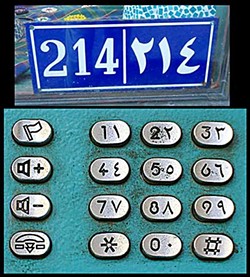[
{
"name": "Top Stories Video Pair",
"insertPoint": "7",
"component": "17087298",
"parentWrapperClass": "fdn-ads-inline-content-block",
"requiredCountToDisplay": "1"
}
]
As for mankind, numbered are their days/Whatever they achieve is but wind.
-- Babylonian clay tablet
Three different styles of writing numbers can be found within half a block of the gazebo in Old Town Eureka.
"Regular" numerals -- 0, 1, 2, 3, 4, 5, 6, 7, 8, 9 -- abound, while the two clocks on 2nd Street display Roman numerals (traditional for clock faces, using the symbols I, V and X for 1, 5 and 10. The other Roman symbols are, as you'll recall from grade school, L, C, D and M for 50, 100, 500 and 1,000 respectively).
On F Street, Talisman Beads and Imports (in keeping with its international offerings) airs its street number both as 214 and ???. The latter symbols are usually (and confusingly) referred to as East Arabic numerals, but are called "Indian" numerals in the Arabic language. In full, they are, from zero to nine: ?,?,?,?,?,?,?,?,?,?. So what are our numerals called? Arabic! (I said it was confusing.) You can appreciate both the similarities and differences in the accompanying photo of an Egyptian public phone keypad.
Both "our" numerals 1, 2, 3 and the East Arabic ?,?,? (from which ours are derived) transparently betray their origin as tally marks. One sack of corn, one stroke. Two sacks, two strokes -- in our 2, with a diagonal line between the two horizontal strokes; in the East Arabic ?, one long and one short vertical stroke joined by a horizontal stroke). Three sacks, three strokes (our 3 having three horizontal strokes joined by "vertical" lines). With four, you can see the four horizontal strokes in the East Arabic ?, but not so easily in our 4.
After that, it gets trickier, for which you can blame the greatest mathematician of the Middle Ages, Leonardo of Pisa, aka Fibonacci (1170-1250), who introduced the number symbols we in the West use today. He did so much more, though. His book Liber Abaci (Book of Calculation) was seminal in converting Europe from the clumsy Roman numbers, with their complicated arithmetic, to the lean, clean, mean system we use today.
Compared with the Roman CCXIV, our "positional" decimal system of ??? or 214 (two hundreds plus one ten plus four ones) looks elegantly simple -- once you know how it's done. Thanks Fibonacci!
Barry Evans ([email protected]) stopped counting the days of his life when he reached ?????. He lives in Old Town Eureka.
CAPTIONS: Top, two styles of numerals, one number, at Talisman on F Street, Eureka. Bottom: Public phone keypad, Cairo (courtesy Pete Hamilton).
Comments
Showing 1-1 of 1
more from the author
-
Doubting Shakespeare, Part 1: Stratfordians vs. anti-Stratfordians
- Apr 25, 2024
-
A Brief History of Dildos
- Apr 11, 2024
-
Eclipse!
- Mar 28, 2024
- More »
Latest in Field Notes
Readers also liked…
-
Trouble on the Line: The Reality Part 2
- Nov 3, 2022

































